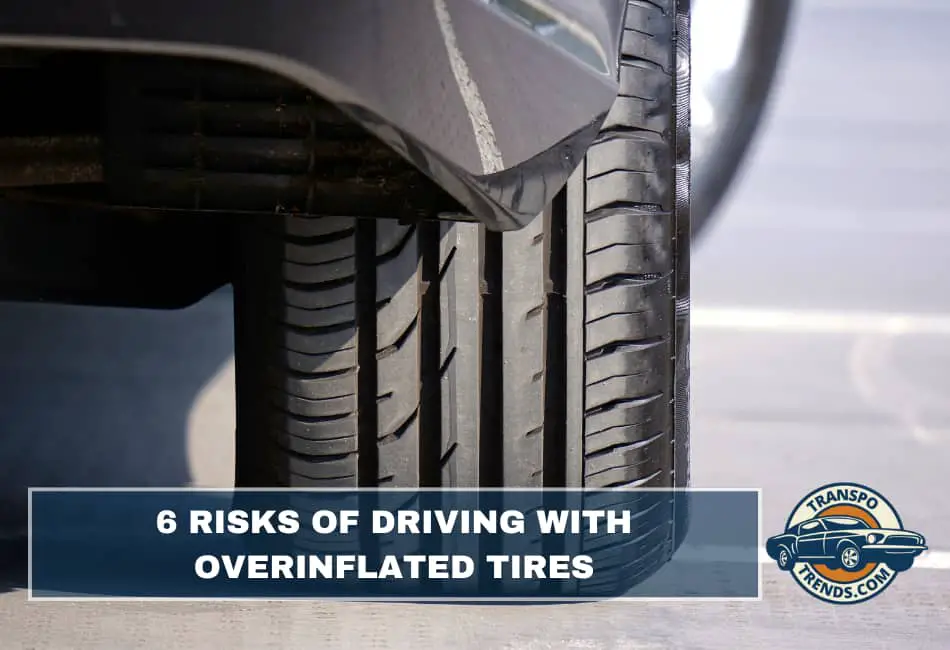Many drivers focus on the dangers of underinflated tires, yet the opposite issue (too much pressure) is also risky. Overinflated tires can affect your car’s handling, safety, and even your wallet in unexpected ways.
Tire pressure is a big deal when it comes to driving safety. On average, nearly 11,000 tire-related crashes occur every year.
That is one reason car experts and organizations like the NHTSA and AAA always emphasize keeping tires at the right pressure.
While underinflation gets more attention for causing blowouts or poor fuel economy, overinflation is an often-overlooked hazard.
Below, we break down six risks of driving with overinflated tires – and why you should avoid putting too much air in those wheels.
1. Reduced Traction and Control
Overinflated tires cause only the middle part of the tread to touch the pavement, drastically shrinking the “contact patch” that provides traction. This is like walking on tiptoes – with less surface area touching the ground, it is harder to maintain a firm grip.
Your vehicle may feel less stable, especially on slick or uneven roads, because so little rubber is actually touching the asphalt.
In fact, AAA notes that overinflated tires have lower traction and an increased risk of skidding. In heavy rain, you could even be more prone to hydroplaning because the tire cannot channel water away effectively when it is only riding on its center
Overall, too much air in your tires can leave you with a car that responds unpredictably when you steer or brake hard.
2. Uneven Tire Wear and Shorter Tire Life
An overinflated tire often wears out down the middle, while the edges remain less worn. This uneven wear can shorten a tire’s usable life significantly. When a tire has too much air, it becomes more rounded, almost like a balloon.
The center of the tread ends up bearing most of the vehicle’s weight and handling friction. That excess pressure on the middle causes the rubber in that area to wear out faster than the shoulders of the tire
In practical terms, overinflation means you will have to replace your tires more frequently because they wear prematurely.
Not only is this costly, but driving on an unevenly worn tire is also unsafe – the thin center tread has less traction and is more vulnerable to punctures.
If you ever spot a tire on your vehicle that looks bald in the middle but still has decent tread on the sides, that is a telltale sign it has been running overinflated.
3. Higher Risk of Tire Blowouts
A tire blowout is one of the most sudden and dangerous events a driver can face. Unfortunately, overinflation increases the chance of a blowout.
With too much internal pressure, the tire’s structure is stretched thinner and any small defect or impact can trigger a rupture.
AAA warns that overinflated tires are more prone to blowouts. Think of an overinflated tire like an overfilled balloon – it does not take much force for it to pop.
Hitting a sharp pothole or road debris when your tires are rock-hard can cause a violent burst of air. Overinflated tires are “stretched beyond their intended limits, making them more susceptible to damage” and failure under stress
If a blowout occurs at highway speeds, you could instantly lose control of the vehicle. The car may swerve or fishtail as the affected wheel’s rubber ruptures.
This poses a grave danger to you, your passengers, and everyone else on the road. It is far better to keep your tire pressures in check than to risk a blowout catastrophe.
4. Harsh Ride and Suspension Strain
One thing you might notice with overinflated tires is how every bump in the road feels magnified. Tires are meant to act as part of your vehicle’s suspension, softening the blow of potholes and rough roads.
But when you pump them up too hard, they become as rigid as rocks. Overinflated tires do not absorb road shocks as well, which means your car’s suspension has to take on more of the impact.
You and your passengers may feel every jolt, and the constant bouncing can be fatiguing on long drives. Over time, the extra stress on components like shock absorbers, struts, and bushings may cause those parts to wear out faster.
In short, driving on over-hard tires can literally shake up your journey (and your vehicle) in all the wrong ways.
5. Longer Braking Distances
Overinflation can also affect your vehicle’s ability to stop quickly when it matters. Properly inflated tires flatten out to grip the road under hard braking, but overinflated tires cannot maintain as much contact with the pavement.
With less grip, your car may require a few extra feet to come to a complete stop. In an emergency those extra feet could make a huge difference.
Moreover, modern safety systems like anti-lock brakes (ABS) and stability control are designed to work best with tires at the right pressure.
If the tires are overinflated, these systems might not perform as intended, potentially lengthening your stopping distance. The ABS may engage more frequently or struggle to prevent wheel lock-up on a stiff, unyielding tire.
Keeping your tires at the correct pressure ensures your brakes and onboard safety features can do their job when you need them most.
6. Greater Risk of Pothole Damage
Air-filled tires are supposed to have some give – that flexibility helps them cushion impacts. However, an overinflated tire is so stiff that it can be easily damaged by potholes and curbs.
When you hit a pothole or bump a curb with an overinflated tire, there is less give to absorb the shock. The rigid tire can suffer a cut, a bulging sidewall, or even a bent wheel rim because it did not flex on impact.
In fact, overinflated tires are more likely to sustain damage from road hazards like potholes or debris. You might end up with a bubble on your tire, a flat, or a dented rim – all of which can be expensive (and dangerous) to deal with.
A properly inflated tire has a better chance of deforming over a bump and bouncing back without lasting damage.
Stay Safe with the Right Tire Pressure
The good news is that all of these overinflation risks are preventable. Here are some tips to ensure your tires are inflated correctly:
- Use the recommended PSI: Always follow your vehicle manufacturer’s recommended tire pressure (PSI). You can usually find this on a sticker on the driver’s door jamb or in the owner’s manual. (For most cars, it is around 30–35 PSI, but follow your specific vehicle’s number.)
- Do not trust the sidewall number: The maximum PSI listed on the tire’s sidewall is not the ideal pressure for driving – it is the upper safety limit. Inflating to that maximum can lead to overinflation issues.
- Check pressure regularly: Use a reliable tire gauge to check your pressure at least once a month, and before long trips. Do this when the tires are “cold” to get an accurate reading. Adjust the pressure if needed to match your vehicle’s specs.
- Mind temperature changes: Remember that tire pressure rises in warm weather and drops in cold. A tire filled on a chilly morning could become overinflated by afternoon as the air expands. If the seasons are changing or a cold snap hits, double-check your pressures.
- Ask an expert if unsure: If you are uncertain about the proper pressure or notice odd wear on your tires, consult a trusted mechanic or tire specialist. It is better to get professional advice than to guess.

